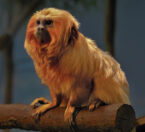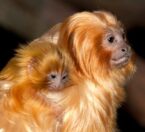Tamarins use a variety of vocalizations to communicate with group members. High-pitched calls and squeaks are used to warn intruders away and to warn group members if predators threaten. Different calls are used for predators in the air (like hawks) and predators on the ground or in the trees. Tamarins also communicate through facial expressions and scent marking.
Classification
| CLASS: | Mammalia |
| ORDER: | Primate |
| FAMILY: | Callitrichidae |
| GENUS: | Leontopithecus |
| SPECIES: | rosalia |
Habitat & Range
Mature humid lowland forest and secondary forest are the main habitat of lion tamarins, and their home range can cover 52-180 acres (21-73 ha). They live in the closed canopy of the forest, moving bipedally using their long fingers to help them stay aloft. These animals can also leap from branch to branch.
Golden lion tamarins live in the remnants of Atlantic coast forest in the state of Rio de Janeiro and across southeastern Brazil. These forests are filled with vines and bromeliads.
Location


Adaptations
- These small tamarins have long fingers and claw-like nails in order to cling to trees, forage among branches, bark, and bromeliads for food and to catch prey.
- These primates are -i.e. manipulative foragers meaning they probe with their elongated hands into tree holes and crevices, breaking up tree bark, and dipping into bromeliads to obtain hidden prey.
- They stay in tree holes for warmth and protection and occupy the closed canopy often remaining 29-100 feet off the ground.
- This species is territorial and defend their area with scent markings or vocalized threats. They also have territorial calls and communicate with others with high pitched trills, whines and clucks that make up their “language”.
Physical Description
- Golden lion tamarins are small primates, their head and body measuring 8.9-11 inches long (22.5-28 cm), and tail measuring 10.4-15.8 inches (26.5-40 cm)
- They weigh between 17-24 oz, 482- 680 grams (males 21.9 oz and females 21.1 oz on average)
- Golden lion tamarins have long reddish golden fur with a mane that covers their ears and frames the dark almost bare face.
Diet
What Does It Eat?
In the wild:
Golden lion tamarins are omnivorous, feeding on fruit, insects, bird eggs, frogs, lizards, snails, other small invertebrates, and plant exudates (gums and nectars) when fruit is not readily available.
At the zoo:
This species is fed a specially formulated canned marmoset diet, veggies, greens, bugs and a small amount of fruits.
What Eats It?
Raptorial birds, (eagles and hawks), snakes-anacondas, rainbow boas and jararacas- as well as tayras and ocelots can prey on golden lion tamarins.

Social Organization
These animals live in groups ranging from 2-11 individuals, most often with more than one adult of each sex. A group often consists of a breeding pair, offspring of 1 or 2 litters and possibly other relatives. They groom like other primates, and the juveniles play, chasing and wrestling each other.
Life Cycle
Golden lion tamarins breed within their group, which includes a single breeding (dominant) female which may mate with a single male (monogamy) or 2 or more males (polyandry); also, there may be breeding by multiple females, usually daughters of primary breeding female. Gestation is 125-130 days, with births peaking in the 2-3 months in early to mid-wet season, during high fruit availability-due the high cost of lactation and carrying the infant. These animals give birth to dizygotic twins, with an average weight of 60g (the twins weight being 20% of the mother’s body weight. In the wild they usually give birth once/year. Infants are carried by an adult, most often the father, but infant carrying can be shared by the mother or other adult males in the group. The young are weaned at the end of 3 months.












